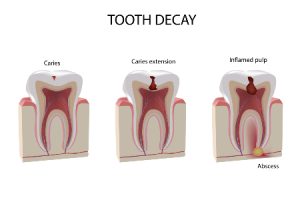
How Does Tooth Decay Happen?
What to know to keep your smile happy and healthy!
Tooth decay isn’t something that happens overnight—it occurs in stages. And the especially bad part is that once this process starts, it’s all but impossible to stop without intervention by a dentist!
Initial caries
A cavity’s beginning stages (often called caries) are usually completely painless. These tiny holes only affect the outermost portion of the tooth (called the enamel). So, individuals are unlikely even to realize anything is amiss. That’s one of the reasons why routine checkups are so important! And once caries form, they will trap even more bacteria and food debris, leading to a bigger and bigger cavity.
Larger Cavities
Eventually, when the cavity penetrates past the enamel and into the tooth’s next layer (called the dentin), you may experience pain and sensitivity to hot or cold temperatures. This portion of the tooth is much more porous than the outer enamel and much more susceptible to further decay.
Tooth Decay & Infection
Finally, in the advanced stages of decay, the innermost portion of the tooth becomes infected. This portion is collectively called the pulp, consisting of nerves and blood vessels. An infected tooth can cause extreme pain and a feeling of pressure within the tooth. From here, the likely course of treatment is a root canal. But have no fear, this procedure is all about relieving pain! We open the tooth’s interior and remove the infection. The tooth is sterilized, filled with a biocompatible material, and finally sealed with a dental crown for strength and durability.
No matter what stage of tooth decay you might be experiencing, it is important to seek treatment as soon as possible. The sooner we can address the problem, the better our chances of saving the tooth (and with less extensive treatments required).

